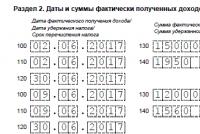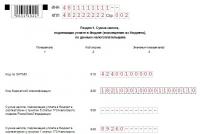Estimation for construction and finishing works. Compilation of estimates in Microsoft Excel Proper compilation of estimates
Estimated documentation is one of the most important elements in the design of any structure or system, and as a rule, in project organizations, there are even entire special departments involved in the compilation of estimates.
The very concept of estimated value arose during the planned economy and in fact was equivalent to the construction price, but should not think that with a market economy, this concept became irrelevant, although the functions of the estimated value and changed, but the need for it remains, and the role even to some extent It has increased, this is due to the fact that, the estimated documentation is a reference point for establishing a contract price for the customer and contractor and in this role is necessary for optimal planning and analysis of costs in both parties, as well as for intermediate cash settlements between them.
The estimated cost of construction is the planned value of the expenditures necessary to create an object in accurately according to the project. Based on the total estimated value, the distribution of capital investments in the years of construction is made, sources of financing are determined, contractual prices for construction products are formed.
It is worth noting that when concluding a contract of contract, the estimated documentation is not mandatory, only the Protocol of the Agreement on the Table of Service is obligatory. However, the Customer has the right to request estimate documentation in any form, with any degree of detail and most of the customers usually enjoy this right to practically, especially if the Customer is a state organization.
Estimated documentation covered by the entire complex of objects under construction is called "summary", as it usually summarizes the documentation for individual objects. If it covers only a specific object or part of it (type of work), it is referred to as "object" or "Local", respectively. The estimated document, which is calculated without detailed detail using enlarged indicators, is usually referred to as the "estimated calculation". If a detailed calculation of the cost of working drawings without consolidation is made, then the document obtained is usually referred to as "estimates".
The estimated cost is established at each design stage, and therefore ensures its gradual detailing and refinement.
In the pre-project stage, under the preparation of "substantiation of investments", a preliminary (calculated) cost of construction is determined on the instructions of the investor . It is compiled according to extremely integrated indicators (per 1 hectares of landlocked land, 1 m3 of the construction volume, per 1 m2 of living space, etc.), for the project at this stage is not yet. In the absence of such indicators, data on the cost of analog facilities can be used.
At the "Project" stage, also enlarged, but more accurate estimated calculations are drawn up. They are based on the drawings of this design stage and include "consolidated estimated construction cost", object and local estimated calculations, estimated calculations for certain types of work, including survey and design (are drawn up before the start of these works) and others. With several types of construction (and, accordingly, several sources of funding) more "consuming costs" by types of construction (for example, hydroelective, industrial, housing, etc.) is drawn up.
The basis for estimated calculations at this stage, as noted, is the project documentation and the current estimate-regulatory framework 1991, or the prices of 1984. With the introduction of appropriate correction coefficients. In the absence of estimated standards, individual rates are used directly for such cases.
At the "Working documentation" stage (RD), object and local estimates are drawn up, and SNIP 11.01-95 allows them to be not compiled if the contract for the implementation of the RD is not provided.
In market conditions of the Russian Federation, four methods for calculating the estimated cost are applied:
Resource
Resource-index
Basic-index
Basic-compensation
The resource method is calculating in current (forecast) prices and tariffs of resources (cost elements). With this method, it is established separately in natural dimensions (m3, ton, piece, person, etc.) the costs of materials and products, the time spent on the operation of machines, the labor costs of workers, and the prices of these resources are accepted by the current (on The moment of drawing up). As a regulatory framework, regulatory indicators of the consumption of materials (NPRM) are used. This method allows for further enough to accurately recount the estimate cost for new prices.
The resource-index method is a combination of a resource method with the resource index index system. Price indexes call the attitude of current prices to the basic. As a basic price, as noted, prices are taken by 1.01.91 and it is permissible to use the prices of 1984. With amendments.
The basic-index method is the use of a system of current and forecast price indices in relation to value defined on the basic level or level of the previous period. Unlike the resource-index method, the separate determination of resource consumption in natural indicators is usually not done. Bringing to current prices is performed by multiplying the basic value for each line of estimates to the appropriate index.
The basic compensation method is that the basis value is determined, taking into account the expected changes in prices and tariffs, and in the construction process it is specified depending on the actual changes in these prices and tariffs.
The choice of the method of drawing up the estimated documentation by law is not regulated and implemented in each particular case, depending on the terms of the contract (contract) and the general economic situation. The most promising is the resource and resource-index methods, however, a basic-index method is prevalent in construction.
The estimated cost of construction and installation works is divided into three main parts:
Direct costs
Overheads
Estimated profit (scheduled savings)
Direct costs include the cost of materials, products, the cost of operating machines and mechanisms, salary of workers. They are determined based on the estimated norms and prices, volumes of structures or types of work, i.e. Any of the above calculation methods.
Overhead costs reflect the costs associated with the creation of general conditions of construction production, i.e. Include the cost of organizing, management and maintenance of construction. They are most often determined as a percentage of direct costs in accordance with the federal standards of overhead, or by individual standards of a particular construction organization. It is also possible to determine the system of indicators of overhead costs by types of construction and installation works or enlarged indicators for major types of construction.
Estimated profit (planned accumulation) is the amount of funds necessary to cover the costs that are not directly related to these construction, but necessary for the further functioning of the construction organization. These are the costs of paying taxes, the development of production and its infrastructure, on material incentives and ensuring the favorable living conditions of workers. Estimated profit is usually determined as a percentage of the total costs or labor costs of workers (for example, 50% of the cost of labor of workers or 12% of the estimated cost of work). Used for this general industry standards or individual norms of a particular organization.
The estimated cost of individual objects and types of work included in the consolidated estimates to industrial and housing and civil engineering is determined by the price list, by estimates to the standard and reusable economical and individual projects associated with local construction conditions, and in their absence - by estimates, Compiled on working drawings.
It should be borne in mind that for unique buildings and structures, as well as for objects, the construction of which will be carried out on experimental or for the first time applied individual projects using typical design solutions, typical designs and parts (for which there are no price-in prices and cannot Emergency for previously developed projects for similar buildings and structures) is used, the estimated cost is determined by the estimates to the technical project, as a rule, according to integral norms (USN), and only in exceptional cases in the absence of enlarged estimated norms - on unit rates For construction work, enacted from January 1, 1969, and price tags for the installation of equipment entered into force from January 1, 1972, and to technology projects - by estimates composed of working drawings.
The cost of certain types of construction (general construction) special (sanitary, electrical, etc.) and generally sloping (vertical planning of the territory, improvement, etc.) of works, as well as certain types of costs (according to an organized set of workers, compensation in connection with the removal of land for development and etc.) are calculated by the estimate of f. Number 3.
Coordinated and adopted by the contracting organization before the construction of objects, the estimated cost of construction and installation work, defined in a consolidated estimate based on object estimates F. No. 2, as well as estimates and estimated calculations for certain types of work and costs (F. No. 3), "is the final and refinement at the stage of development of working drawings, it serves as a basic document for the calculation between the contractor and the customer for the work performed.
The estimated cost of the equipment required for the facilities under construction and costs associated with its installation is reflected in the estimate of F. No. 4, for housing and civil construction.
As in f. No. 4 The amount of wages for installation work is calculated for each position of the estimate of the estimated path and is the work of time consuming, then from January 1, 1973, a new procedure for determining wages was established. Thus, when drafting, the amount of wages is determined by electrical installation work using coefficients from the estimated value of these works, calculated at sections 1-6 and 16-24.
The use of these coefficients provides the possibility of binding wages (maintenance and maintenance of machinery) to local working conditions. An increase in the estimated cost of electrical work due to increased wages due to complex local conditions for performing the work, is determined according to the following formula: DS \u003d C x (P-1) x to
Before carrying out any costs, there are almost always planning. In essence, the definition of approximate amounts sent to certain articles of costs and is a preparation of the estimated costs. Moreover, it may concern both solutions of everyday issues in human life and, to an even greater extent, the activities of enterprises and organizations. Almost everything is engaged in planning costs in one form or another.
Determination of estimates of expenses
Under the cost estimates, it is usually understood that the calculation of all the costs needed to perform the planned works, the production of the product, the implementation of activities related to the achievement of the intended objectives of the organization and other similar situations. Sometimes the preparation of the document is performed on a voluntary basis. However, quite often the development of cost estimates, as well as its subsequent approval and coordination are the requirement of Russian legislation. For example, the preparation of the balance of spending and income (which is a kind of estimates of expenses) - one of the mandatory conditions for the work of any non-commercial organization. Given that their number is large enough, it becomes clear why the question is how to make estimates competently and as much as possible, so much attention is paid.
Non-commercial organizations (NGOs) include:
- educational (University, Kindergarten or School), Cultural (Museum, National Park or Exhibition) Medical (Polyclinic, Dental Center, etc.) Public and private institutions;
- HOA, housing and consumer cooperatives;
- organizations on the protection of the rights of citizens;
- local and government bodies;
- charitable funds and organizations;
- religious associations;
- divisions of the Ministry of Defense, Ministry of Emergency Situations and the Ministry of Internal Affairs.
For all of the above organizations, the annual compilation of costs and income, as well as a final document containing information on its execution. Particularly strict requirements are presented to state government institutions that are partially or fully funded from the budget. In this case, the entire procedure is clearly prescribed, ranging from the timing of the development of the document under consideration and ending with the requirements for its approval and coordination.
Scope of cost estimates
Given the large number of non-profit organizations, the examples of which were given above, becomes understandable to the relevance of the issue of competent compilation of estimates and the subsequent execution. Between the quality of these processes, the level and the degree of control over the distribution of a significant part of the state budget is determined. It is not surprising that precisely non-profit organizations are regulated in the most detailed and controlled, in which budget funds are present in one degree or another.
At the same time, we should not forget that estimates are drawn up not only where government financing is present. As an example, it is possible to bring the situation, to face with which in real life I had to almost everyone. The level of utility costs in homes that are under the control of HOA is determined, including, and by drawing up cost estimates for the next year, as well as analyzing the execution of the document developed in the past calendar period.
In this case, the estimates must be not only as accurate as possible, which is important for residents at home, not wanting to overpay, but also accessible and easy to check. It is no secret that some representatives of utility services prefer to deliberately complicate the calculations performed - it is much easier to confuse payers and make them large than necessary, amounts for payment.
An equally important area of \u200b\u200bapplying estimates is their compilation in commercial organizations, in particular, in industrial enterprises of any form of ownership. In this case, the purpose of paperwork usually performs the calculation of the cost of manufactured products necessary to determine the sale price. Obviously, in modern market conditions, the importance of competent execution of this process is difficult to overestimate.
Example of cost estimates
As noted above, the highest requirements for the preparation of cost estimates are imposed on budgetary institutions. Therefore, it will be quite logical to consider a specific example of a personal settlement, since the fulfillment of other options in most cases is much easier.
As a similar simple example, you can bring the option of completed cost estimates and incomes of a non-profit organization.
The document consists of two main parts. In the first of these, sources of income formation are indicated, and in the second - the directions of their spending with a clear indication of the amounts on the costs of costs and the implemented programs and distribution through quarters. As a result, after studying the estimates, a clear idea is created as the basic parameters of the organization's activities on the planned calendar period.

As can be seen from the above example, design, coordination and approval of the document under consideration are carried out in an arbitrary form. Much above the requirements imposed in the preparation of estimates of costs and income by the budget institution, form and an example of which are shown below.
Regulatory acts are clearly prescribed by the form of the document, its structure, as well as how to make estimates in such a way that it corresponds to the current Russian legislation. In this case, the document cap looks like this.

The calculated part of the document consists of four sections: in the first three contains data on the main costs of the organization, which are summed up in the final fourth.

In this example, there are no costs for the second and third partition, so the final almost repeats the data of the first separation into several modified format. The estimates of expenses are signed to those who amounted to it, checked and the head of the budget institution.

Anyone who wants to build a house or make repairs in the apartment, initially counts what amount it will cost him. For complete clarity, it is necessary to draw up a list of necessary materials and works, as well as their cost. Based on this, it will be possible to find out how much money will need. And also decide, attract builders or do everything yourself. How to make a estimate which positions in it include and how to calculate everything correctly, not everyone knows. Let's try to figure it out.
What is esthese
The estimate is a document that systematizes all costs for the upcoming construction or repair. It can be easily done independently without having specially developed programs.
How to make sure your forces? It is enough to have an Excel program on your computer. It is necessary to carry out the calculation of funds and materials to be very carefully in order to avoid errors and exceeding the planned costs. It should be displayed all to the smallest detail.
Frequently allowed errors
When drafting the estimates, many allow them to be launched, which then float out and provoke unforeseen embellites:

- Counts are carried out without a preliminary inspection of the object on which work will be performed.
- There are no additional costs that may arise with force majeure circumstances.
- The full list of works and materials is not taken into account.
The main expenditure document for repair or construction requires a serious approach and accurate calculations. Otherwise, you can get the wrong results.
What is necessary for competent compilation of the estimate
Before compiling the estimated estimate for construction or repair, first of all, it is necessary to inspect the object. After that, you should draw up a list of all work carried out.
How to make a estimate? Need to know construction technology. Without this, it is impossible to competently and correctly calculate and write down all the upcoming costs. Therefore, we recommend before you make a estimate, study the sequence of the production cycle of the work that needs to be regarded. This will help to understand the need for conducting operations and the need for building materials.

The main positions of the estimates
Any construction estimate consists of three main positions:
- materials;
- work;
- transport.
All other items (the cost of electricity, the operation of equipment, etc.) is joined by them.
In the first position indicate a list of necessary materials for each cycle of work, a unit of measurement, quantity and price. For example: brick, glue, plaster, cement, wallpaper, linoleum and others. This also includes "consumables" (brushes, rollers, gloves, etc.). Before making a estimate, find out the cost of materials directly in the store, or find on the Internet on sites specializing in the sales of building materials.

The second position includes the listing of all the actions performed. Here you need to consider both preparatory and finishing works, their complexity and conditions in which they are held. For example, you need to leave the room with new wallpaper. To do this, it will be necessary to conduct preparatory work: remove the old coating, clean the walls, primed them. The approximate cost of the necessary work can be found in the ads.
The position "Transport" includes: delivery of materials, unloading, removal and removal of construction waste, indicating each item with a separate line. Information on the value of these services is provided in the prices of firms.
Drawing up estimates for apartment repair
How to make a estimate to carefully plan the repair work in the apartment, finish them in a short time with minimal expenses? First you need to decide what kind of repair you will do: Cosmetic or Capital. This depends on the number of necessary materials and the scope of work. If you decide to overhaul, then the estimate should be divided into two parts:

- repair and finishing work;
- black and finishing materials.
How to learn to make a estimate to avoid mistakes? To do this, we should explore all the rooms of the apartment, to measure the surface area of \u200b\u200bthe walls, floors, window slopes, make a list of finishing and draft materials, determine the cost and volume of work of each room separately.
Example
Let us give an example, how to make a estimate for repairs. Prices and consumption of materials fictional.
Repair and finishing works:
Place of work | Type of work | unit of measurement | number | Price per unit measurement, rub. | Total amount, rub. |
Putty | |||||
Alignment | |||||
Painting | |||||
Alignment | |||||
Putty | |||||
Fucking wallpaper | |||||
Dismantling | |||||
Laying tiles | |||||
Plinths | Dismantling | ||||
Installation | |||||
Sockets, switches | |||||
TOTAL | |||||
Consumables and finishing materials:
Material | unit of measurement | number | Price per unit measurement | total amount |
Start Putty | ||||
Finishing putty | ||||
Glue for wallpaper | ||||
Acrylic paint | ||||
Glue for tile | ||||
Plinths | ||||
Socket, switch | ||||
Gloves | ||||
TOTAL | ||||
Transport:

To get the preliminary results of the cost of repair of the apartment, you need to fold the final sums from each graph.
18819 + 7870 + 4000 \u003d 30689 (rub.)
It should be known that the final costs always come out by 10-15%.
30689 + 15% \u003d 35292.35 (rub.)
The principle of calculating the cost of construction does not differ from the estimate for repairs. Only change production cycles and materials. How to make a estimate for construction with minimal expenses? To do this, it is necessary to carefully plan all the work, clarify which materials will need, learn the rates.
Drawing up the estimates is a very important stage from which any repair or construction should be started. A properly compiled document will help to carefully plan and rationally distribute costs - both material and money. The main thing is to seriously refer to counting and fulfill them as accurately as possible.
The formation of estimates for construction and finishing works is the necessary part of the execution of the contract for the construction and repair of various kinds of objects.
Files
In what cases is a document drawn up
Estimation for construction and finishing works can be drawn up in addition to the contract both between legal entities and individual entrepreneurs and between individuals.
Construction and repair objects can also be the most different:
- private houses and apartments;
- buildings and structures belonging to commercial organizations or government agencies;
- individual rooms or whole complexes of buildings, etc.
What does the document need
Estrase is a preliminary calculation of the value of building materials and services.
This document is necessary in order for the Customer under the Agreement to have a clear idea of \u200b\u200bwhat costs for repair and construction will come to him.
In some estimates, in addition to the collaboration of actually expenses, a period of conducting certain works is made. After drawing up and sight, the document allows the customer to better control the work performed.
If we consider the role of estimates from the point of view of accounting, then it is also quite obvious: it is based on its basis in most cases a wondering of the value of materials, construction and repair work.
If we talk more accurately, the write-off occurs after signing by the customer and the performer of the primary accounting document: the act of work performed, but the estimate confirms the accuracy of the work and materials prescribed in it.
The more thoroughly and more accurate will be designed, the less likely that there are some disagreements and controversial moments during the work between the customer and the performer.
Is it permissible to break the numbers specified in the estimate
A feature of the document is the guarantee that the prices specified in it will remain unchanged.
Since the estimate is usually preliminary in nature, during the period of actual execution of work (especially if they are long-term), some prices can change significantly.
Also require adjustment may also amount to materials.
Usually such an opportunity is prescribed in the contract or the residue itself (for example, the fact that prices can be increased by 10%, etc.).
If there is no such point in the estimate, then all changes must be consistent between the customer and the Contractor in the process of executing the contract and if the customer does not object, the estimate can be edited.
In situations where the Customer does not agree to the increase in the cost of the work declared in the estimate, the Contractor has the right to refuse to fulfill the terms of the contract.
Who is authorized to do the estimate
Usually, the obligation to form the estimation of the estimate lies on the head of the structural unit, which is directly engaged in the execution of work (brigadier, head of the workshop, plot, etc.). In any case, it should be a person who knows the standards for spending certain building materials, has an idea of \u200b\u200btheir market value, as well as a sign with the rules for the preparation of this kind of documents.
How to form a blank
Today, the unified form of the estimate does not exist, so representatives of enterprises and organizations can compile it in an arbitrary form or, if the contracting company has a developed and approved typical pattern - according to its sample. In this case, regardless of which method it is selected, it is necessary that according to its structure, the document corresponds to some standards of office work, and in the text included a number of certain information.
In the "cap" are standard:
- number, place, date compilation form;
- information on organizations between which a construction and finishing contract concluded;
- a reference to the contract itself is given (its number and date of concluding is indicated);
- posts, names, name-name-names of managers fit.
- serial number;
- name of work;
- unit of measurement of work (square meters, kilograms, pieces, etc.);
- price per unit of measurement;
- total cost.
If necessary, you can add additional columns (for example, about the number and cost of the material being expended, information about the devices used, equipment, technician). The length of the table depends on how many works are planned. For convenience, the table can be divided into sections depending on the type of work (plumbing, painting, carpentry, assembly, etc.).
Under the table should be made of whether prices are final or during the work of work can be adjusted.
How to arrange estimates
Important condition! It must be signed by directors of two enterprises: the customer and artist (or individuals authorized to act on their behalf), while the signatures should only be "alive" - \u200b\u200bthe use of facsimile options is not expected.
The estimate can be certified using the seals of organizations, but only in the condition that the use of stamp products is registered in their internal locally regulatory acts.
The estimate is made in two identical text and equivalent to the right copies, one for each of the stakeholders. After drawing up and sight by both parties, the estimate becomes an integral part of the contract, so its presence should be recorded in the Internal Documentation Journal.
Construction is a very time-consuming process, which includes the implementation of various technical, repair and loading and unloading work. In addition, a large number of construction equipment is used to build the object, workers' brigades are attracted. In a word, the number of stages of the construction may well be confused both the customer and the performer, which will lead to the possible appearance of "non-target expenses", so at the beginning of construction or repair work, it is necessary to make a estimate to know exactly where cash should be consumed.
Types of estimates and methods for calculating
Estrase is a document that is consistent between the customer and the Contractor and contains a complete list of types of work planning to fulfill the construction, building materials, technical equipment, etc. The document also indicates the volume of all listed units, the cost per unit and total amount. In addition, the estimate contains information on the cost of the work specified in it, standards and deadlines for the work, the cost of labor payment workers, rental and operation of technical equipment in base prices, as well as the recalculation coefficient to current prices.
In order to understand how to make an estimate, you need to know which kinds of this document are. Highlight three main types of estimates:
- local;
- object;
- summary.
Since construction is a sufficiently long process, then it is impossible to consider all the nuances before booking. The contractor cannot know in advance which types of work will be required and will there be any complications or force majeure. Therefore, in the current construction process, local estimates are used, in which all costs, cost and deadlines for a specific type of work are taken into account. Local estimates are used to compile an object of object type - this kind of estimate describes the construction object completely. Consolidated estimates are compiled from object and need to describe multiple construction objects.
As mentioned above, it is impossible to accurately predict how the cost of labor, material resources and construction equipment will change over time, therefore the estimate is drawn up on the basis of basic prices compiled in 2006, which are then translated into the current. There are four methods how to translate the estimation at current prices:
- basic-index;
- basic compensation;
- resource;
- resource-index.
The basic-index method implies the use of forecast and current indices relative to the costs defined by the basic prices or prices of the previous period.
The basic-compensation method is applied using predicted prices compiled on the basis of basic taking into account the expected growth / decline, which are adjusted by the fact during the construction process.
Resource method - costs in the estimate with this approach are indicated in natural values, which are then calculated on the basis of current prices, which are determined at the time of drawing up the estimated document.
The resource-index method is the method similar to the basic-index with the only difference that the calculation is performed in natural values.
The regulations on the use of the type of calculation of the estimate does not exist - for each specific object, an independently selected view of the calculation is applied, which is prescribed in the contract.
Algorithm of work to adjust estimates
Financial investments are not limitless, so if the project is too much, the question arises, how to reduce the estimates to meet the planned budget. There are several ways:
2. As a rule, construction materials are purchased with a 10% margin for unforeseen expenses, so you can discuss with specialists, where it is advisable not to do this to save. It also applies to the hiring of workers, and allocating time for construction work. To make a estimate that will save the budget, consult from professionals: what types of work can be reduced by time or abandon them at all, where the number of workers can be reduced, and where to cut the amount of materials used.
Stages of self-development estimates
The services of the estimator are quite expensive, so in order to save it, using the following scheme, disassemble how to learn to do the estimate yourself:
1) First of all, it is necessary to study the estimated standards. There are three types of standards:
Their main difference is the scope, so you need to know which type of construction will be applied - from this will depend on which units of calculation should be applied.
2) Deciding with the base, you should choose the type of calculation, which will be used in this project.
3) Make the types and number of estimates by combining them into a single structure. It is necessary to know how much local and object estimates will be applied, which are then combined into a single consolidated estimate.
4) The next step is the direct calculation of the estimates. To know how to write a estimate at this stage correctly, it should be thoroughly examined which types of work will be applied, how many units of technology, building materials, workers and time will need this, as well as standard rules of implementation.
6) After calculation, it is necessary to bring the document to the corresponding form, the form of which is determined by the regulatory framework.
According to the rules, the estimation is divided into three components:
- direct costs - Purchase of building materials, rent / purchase of special equipment, workers' payments;
- overhead costs are the costs that pay for the organization of the construction process and its administrative part;
- estimated profit is the type of costs that the contractor comes to pay for remuneration.
To make up the estimates, it is better to use professional services. There are many companies that provide these services. It is enough to conclude an agreement to draw up the estimates with it and pay for work. As a rule, the companies provide written guarantees on the correctness of the estimated estimates and are ready to argue each item provided by the document.






